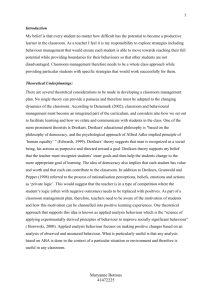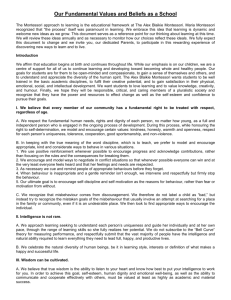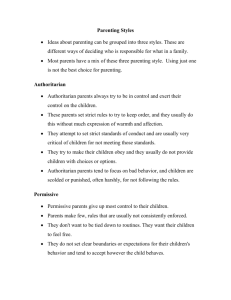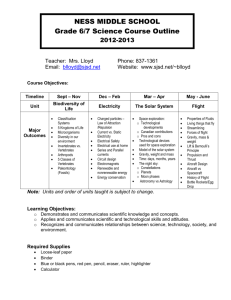Paper - ILPC
advertisement
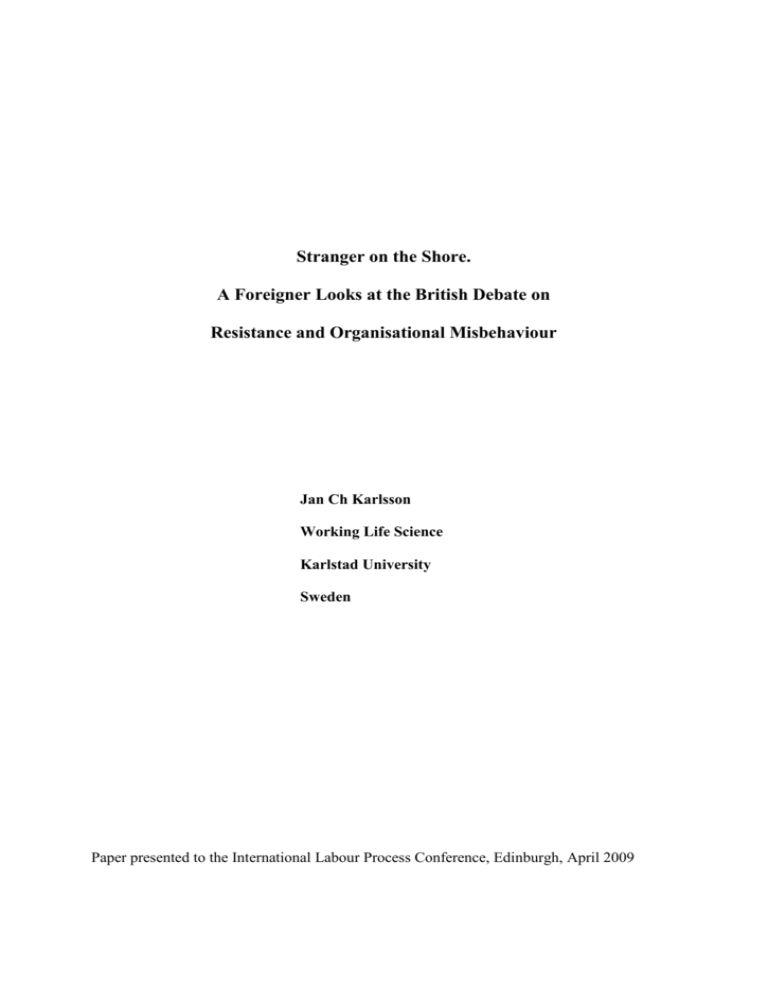
Stranger on the Shore. A Foreigner Looks at the British Debate on Resistance and Organisational Misbehaviour Jan Ch Karlsson Working Life Science Karlstad University Sweden Paper presented to the International Labour Process Conference, Edinburgh, April 2009 2 Jan Ch Karlsson Stranger on the Shore. A Foreigner Looks at the British Debate on Resistance and Organisational Misbehaviour The stranger, Simmel (1950) says, has a position that makes it possible to see things differently. Although he also talks about the stranger being more objective, I do not make any such claims. And I have reasons for that: What first made me interested in resistance at workplaces was a research overview of Western Europe in which it was said that in Sweden research on resistance would be unthinkable and that there is no resistance at Swedish workplaces (Edwards, Collinson & Della Rocca (1995:285, 303). The authors were foreigners to Sweden, but that did not help – they were wrong. I knew that then from my own experience, first as an industrial worker and then at universities, and now I know it from research that we are carrying out at the moment (Huzell 2005, 2009; Karlsson 2008; Strömberg 2007; Strömberg & Karlsson 2009). Simmel also says that strangers often carry out tasks that natives are not capable or willing to perform (cf Karakayali 2006). It is probably natural that those engaged in the British debate on resistance and organizational misbehaviour emphasize the differences between concepts and approaches. Still, it has surprised me a little that the debate does not seem to have led to anyone changing his or her mind. I have not been able to find anyone saying to the opponent: ‘I was wrong on that point and you were right.’ From my point of view as a stranger the debate is less a debate than trench warfare. In this paper I will not take sides very much. Instead I look at possible relationships between some of the concepts mentioned in the debate. I disregard, though, some extreme positions, such as resistance being either trivial or impossible (Contu 2008), or that it is a shortcoming to conceptualize resistance as actions rather than identities and subject positions (Thomas & Davies 2005). Organizational misbehaviour The publication of the Thompson and Ackroyd (1995) article ‘All quiet on the workplace front? A critique of recent trends in British industrial sociology’ is a watershed, strengthened by their later book Organizational misbehaviour (Ackroyd & Thompson 1999). They reacted strongly to a tendency in much of British resistance studies to regard resistance as nonexistent – capitalists and management more generally had won the battle. Ackroyd and Thompson claimed that there still is resistance at British workplaces, and not only that: It is common, they said. They seemed, though, to give up on the concept of resistance. Instead they offer another approach, centred on the concept of ‘organisational misbehaviour’. This has had a great impact: It is very hard to find a text in the field that does not relate to this analysis in one way or another. To this foreigner this turn of the British debate is welcome. The pre-Ackroyd and Thompson intervention analyses seemed to turn British analyses into the Edwards, Collinson and DelaRocca picture of Sweden: There is no workplace resistance. With an ironic twist, Ackroyd and Thompson use the term ‘misbehaviour’ in opposition to the organisational behaviour tradition, in which it is taken for granted that employees always do what management wants them to do. They always follow the rules. At the same time it is a well-known form of resistance to follow all rules, to ‘work to the rule’ – something which has made jurists raise the question whether working to rule really is a breach of the contract of 3 employment (Napier 1972). When employees follow all rules, the process of work quickly breaks down. In other words, organisational behaviour is organisational misbehaviour, and a certain amount of organisational misbehaviour is necessary if work is to take place. Employees are not in practice supposed to do exactly as they are formally supposed to do; they are also supposed to use their own judgement and creativity to make work function. Ackroyd and Thompson (1999:81) treat this question as one of three factors that ‘affect the judgements managers make about the appropriateness and likely effectiveness of taking action against specific instances of potential misbehaviour.’ I think it is more than that: Working to rule is a basic paradox of organisational misbehaviour. It follows, for example, that the ideas of workplaces in which there is no room for resistance must be met with scepticism. I regard organizational misbehaviour as the generic term for the field in question. Ackroyd & Thompson (1999:2) define organizational misbehaviour as ‘anything you do at work you are not supposed to do’. But I would like to add two dimensions to it: ‘anything you do, think and are at work you are not supposed to do, think and be’. Even if what people do, their actions, are what counts in the final analysis, there are three reasons why I think that make these processes should be included in the definition. The first is the enormous resources employers put into indoctrinating employees’ thinking and identity through corporate cultures. The second is reactions from workers such as these: Management try ‘to get inside your head’ (Ezzamel et al. 2004:289); ‘Basically they are trying to change your personality’ (McKinlay & Taylor 1998:179); and ‘they were trying to brainwash me’ (Huzell 2005:245). Finally, Ackroyd and Thompson themselves stress that identity is important for organisational misbehaviour; they say for example (1999:26) that ‘without the formation of a distinct identity by employees, any and all other forms of misbehaviour are difficult to envisage.’ Subsets of organizational misbehaviour At the centre of organisational misbehaviour is the hierarchy of command: Managers define which actions, thoughts and identities are organisational misbehaviour for workers, and managers at high levels define what is organisational misbehaviour for managers at lower levels. The other terms I will discuss cover parts or subsets of misbehaviour. This should be taken account of in the formulation of the other terms. There should first be the definition of organizational misbehaviour that I just presented, but then there should be another part that states what is specific for each term within this framework. As the power hierarchy is of central importance here, the latter part of the definitions are built up according to different directions in relation to this hierarchy within the workplace. Resistance is, I suggest, ‘anything you do, think and are at work you are not supposed to do, think and be, and that consciously is directed upwards in the hierarchy’. Here is an example from an office, where a worker says (Taylor & Bain 2004:289): The dress code changed and we were told, “You have to wear a shirt and tie”. So we got word round, “Tomorrow, wear shirts and ties that make us look as unprofessional as possible”. I wore a tie about four or five inches wide, illustrating the history and future of the motor car in glorious technicolour, along with a purplechecked shirt. Everybody dressed like this and there was nothing management could do. Already the next morning management withdrew the dress code. 4 ‘Directed upwards in the hierarchy’ – that means that the actions, thoughts and identities can exist wherever you are positioned in the hierarchy: There is always someone higher up. And there is a lot of resistance going on within management, among managers at different levels. A classic example that sociologists of work seldom consider as it is regarded as belonging to political science, is senior officials’ potential resistance to ministers in government departments (Barker & Wilson 1997). Here is a perhaps more familiar example from the industry, concerning the relation between plant managers at sewing factories and the corporate headquarters. The corporate idea is that ‘senior management make strategy, then plant level management manage change’ (Taplin 2001:6). The basic device in the change strategy was to implement teams and the plant managers did so, and in the beginning they followed the headquarters’ intensions. But after about a year, they noticed that their bonuses went down drastically, despite the improvements that followed the changes. It turned out that the bonus system could not register the types of improvement they had made when they followed senior management instructions. So they started to make other types of changes – changes that were registered by the bonus system. That is what lies behind this quote from a plant manager (Taplin 2001:17): They (corporate) wanted gains in productivity, costs, quality and improved flexibility. Teams were meant to do this but often the opposite occurred. So we changed the emphasis of teams to meet productivity goals, cut supervision and forced workers to pay more attention to quality. In the last couple years we’ve done quite well (…) But the big thing is that I’m able to deliver key numbers at the end of the year. The CFO is happy although I must admit there’s a lot of creative accounting going on. The plant managers resisted the corporate managers intentions, which led to less good results for the corporation but better bonuses for the plant managers. While organisational misbehaviour is an active appropriation of resources to become more autonomous, resistance is that part thereof that makes up an answer from employees in relation to control from management higher up in the hierarchy. There is, however, no consensus among researchers about what we should regard as resistance. The term, Weitz (2001:669) claims, ‘remains loosely defined, allowing some scholars to see it almost everywhere and others almost nowhere’. An underlying theme in most definitions (Hollander & Einwohner 2004; Seymore 2006) is nevertheless that resistance is intentional: The aim of the acts, thoughts and identities are oppositional to the power of superiors. That is the way in which it is directed upwards. Organizational misbehaviour in general does not have to be a conscious opposition in order to change the frontier of control in the contested terrain of the workplace. It is possible to break management rules without intending to do so. Resistance is that part of organizational misbehaviour that intends to move the frontier in favour of a certain group of employees. Bullying is ‘anything you do, think and are at work you are not supposed to do, think and be, and that is directed downwards in the hierarchy’. Most work organizations have explicit, formal rules against all forms of bullying – often expressed as a ‘zero tolerance’. Still, the literature is full of examples of managers bullying lower managers and lower managers bullying workers. This is a fairly mild example from an industry (Cavendish 1982:97): Tweedledum, Tweedledee and the other managers seemed like cardboard characters, and we thought them rude and bad mannered. Even if they stopped right by you or 5 took the UMO [the product] out of your hand, they acted as if you weren’t there. If they went through the heavy rubberised swing doors into the main assembly in front of you, they let them swing back on you, which no worker would ever do…. They had so little respect for the workers that they couldn’t even admit we existed. Bullying may also lead to resistance from those who are subjected to the treatment. At a nightclub there were heavy security shutters that were to be lowered when the bars closed. They were, however, old and did not function properly. Often there were near-accidents and the employees often complained about the risks. Management refused to have them renovated or changed – the costs would be astronomical, it was said. But: Once new shutters were installed – following injuries to two of the clients – the managers laid down new rules as to how they should be operated. The General Manager, pointing to the new shutters, proclaimed: “Those shutters cost 1,000 quid, more than all of you are worth. I can replace you lot anytime I wish, but I can’t afford those shutters again. Make sure that they’re not dropped on the counters.” It was interesting to see that the very participants who had insisted on the replacement of the old and dangerous shutters were now pulling the heavy steel shutters down so vigorously that they were soon rendered useless. As one employee pointed out: “If the shutters are worth more than me (workers) do you wonder how much exactly we are each worth … down with the shutters …” (Analoui & Kakabadse 1989:37) Probably, the most important concept in Ackroyd and Thompson’s analysis is ‘self organisation’, by which they mean (1999:54) ‘the tendency of groups to form interests and establish identities, and to develop autonomy based on these activities’. This combination of self-identity and self-interest is the basis of employee action in the workplace. Selforganization leads to at least two types of organizational misbehaviour: Group discipline and internal power struggles in the self-organized group. And all self-organization is of course misbehaviour. Group discipline is ‘anything you do, think and are at work you are not supposed to do, think and be, and that is directed laterally in the hierarchy in order to keep discipline among employees in situations of collective resistance’. Ostracism is, for example, a common way to do so. An example from a factory in which management had introduced peer reviews in the teams (McKinlay & Taylor 1996, 1998): The team members were supposed to scrutinize each other’s performance and take ‘corrective action’ towards any employee deviance from the standards concerning efficiency, quality and behaviour. The teams were supposed to be collective agents to discipline workers on behalf of management. But gradually more and more team members regarded peer reviews not as the opposite of management control, but a new form of controlling employees. Resistance strategies to neutralize the peer review process began to develop in some teams and a growing self-organization helped spreading the strategies, which resulted in a new type of collective discipline – a discipline within the selforganized group. A worker who was transferred from a team in which the members were still judges of each others’ adherence to management requirements to a team with selforganization told about his experiences (McKinlay & Taylor 1998:187): If you come in and start giving people 2s, which is saying that there’s room for improvement, people will stop talking to you. So you change and start giving people higher scores. The minimum you give is a 3. 6 This is not the management-induced collective discipline, but the internal discipline that is necessary for self-organized groups to act collectively. But hierarchies develop also within self-organizations – hierarchies that will be enforced and that can lead to internal power struggles. The ethnographic literature is full of descriptions of lateral contradictions between workers – and here is one of them (Ackroyd & Crowdy 1990:6): Younger and weaker members of the team would often be subjected to extreme pressures by more experienced or skilled men. One recurrent example of this was an aspect of normal work performance, in which the completion of work would be used to harass certain workers. This possibility arose because the speed of the line tended to be set by the average speed of all, leading to a build-up of work at the stations of the slower men. Attempting to work faster than the next man was an objective every worker would aim at if the opportunity arose, and for the more experienced and skilled it arose on a regular basis. When it was achieved it would be accompanied by a rising tide of comment on the inferior performance and general inadequacy of the operative in difficulty. My interpretation of group discipline and internal power struggles is, I think, fully in line with Ackroyd & Thompson’s (1999: Ch. 3; 108) analysis of self-organization. Some organisational misbehaviour does not emanate from the workplace, but from life outside work. Employees are more than employees – they have a life outside work. And that part of life is active also during working hours – employees engage in private activities at work. Private business is ‘anything you do, think and are at work you are not supposed to do, think and be, and that is directed outwards from the hierarchy’. We catch glimpses of private activities now and then in the literature on organisational misbehaviour, but mostly concerning specific types of private business; two examples are what is sometimes called ‘poaching’ in industry (Anteby 2003) and ‘cyber loafing’ in offices (Lim 2002). The most comprehensive study so far (D’Abate 2005) builds on interviews with 30 middle managers in offices. I will not go into the results in any detail, but just mention that all of them were engaged in private business at work. It did not only concern activities (such as private phone calls and e-mails) and private thoughts; keeping their private identity at work was also important (D’Abate 2005:1024): I would say that [I do home and leisure type activities] to not forget about them during the workday … to recognize that everything is not all about work … in this day and age, oftentimes work is so all-encompassing that it’s easy to forget about the other things in your life, and I think it’s healthy to incorporate those other areas that make you the person that you are that comes to work every day. Conclusion In existing empirical research the phenomena I have mentioned are usually analysed as separate entities without connections to each other. I suggest that fruitful empirical studies could also be made by analysing the relations between organizational misbehaviour, resistance, bullying, collective discipline and private activities. The reason that I have given so many empirical examples is that I wanted to point out that they are all instances of 7 organizational misbehaviour – but that they at the same time can be regarded as separate examples of the different subsets of misbehaviour. ORGANIZATIONAL MISBEHAVIOUR Resistance Collective discipline Private business Internal power struggl es Bullying Figure 1. Subsets of organizational misbehaviour in relation to the hierarchy of command What keeps them together is their relation to the hierarchy of command at the workplace; what make the distinctions between them are the different directions that they take in relation to this hierarchy (Figure 1). 8 References Ackroyd, Stephen & Peter Crowdy (1990): ‘Can culture be managed? Working with “raw” material: The case of the English slaughtermen.’ Personell Review, Vol. 19, No. 5, pp 313. Ackroyd, Stephen & Paul Thompson (1999): Organizational misbehaviour. London: Sage. Analoui, Farhad & Andrew Kakabadse (1989): ‘Defiance at work.’ Employee Relations, Vol. 11, No. 3, pp. 2-62. Anteby, Michel (2003): ‘The “moralities” of poaching. Manufacturing personal artifacts of the factory floor.’ Ethnography, Vol. 4, No. 2, pp 217-239. Barker, Anthony & Graham K. Wilson (1997): ‘Whitehall’s disobedient servants? Senior officials’ potential resistance to ministers in British government departments.’ British Journal of Political Science, Vol. 27, No. 2, pp 223-246. Cavendish, Ruth (1982): Women on the line. Boston: Routledge and Kegan Paul. Contu, Alessia (2008): ‘Decaf resisitance. On misbehaviour, cynicism, and desire in liberal workplaces.’ Management Communication Quarterly, Vol. 21, No. 3, pp 364-379. D’Abate, Caroline P. (2005): “Working hard or hardly working: A study of individuals engaging in personal business on the job.” Human Relations, Vol. 58, No. 8, pp 10091032. Edwards, Paul, David Collinson & Giuseppe Della Rocca (1995): ‘Workplace resistance in Western Europe: a preliminary overview and a research agenda.’ European Journal of Industrial Relations, Vol. 1, No 3, pp 283-316. Ezzamel, Mahmoud, Hugh Willmott & Frank Worthington (2004): ‘Accounting and management–labour relations: the politics of production in the “factory with a problem”.’ Accounting, Organizations and Society, Vol. 29, No. 3, pp. 269-302. Hollander, Joycelyn A. & Rachel L. Einwohner (2004): ‘Conceptualizing resistance.’ Sociological Forum, Vol. 19, No. 4, pp. 533-554. Huzell, Henrietta (2005): Management och motstånd. (Management and resistance). Karlstad: Karstad University Press Huzell, Henrietta (2009): ‘Striving for flexibility, attaining resistance – culture clashes in the Swedish railway industry’, in Egil J. Skorstad & Helge Ramsdal (eds.) (2009): Flexible Organizations and the New Working Life: A European Perspective. Aldershot: Ashgate. Karakayali, Nedim (2006): ‘The uses of the stranger: circulation, arbitration, secrecy, and dirt.’ Sociological Theory, Vol. 24, No. 4, pp 312-329). Karlsson, Jan Ch (2008): Den smidiga mellanchefen – och andra motståndsberättelser. (The Flexible Middle Manager – and Other Resistance Stories) Malmö: Gleerup. Lim, Vivien K.G. (2002): ‘The IT way of loafing on the job: Cyberloafing, neutralizing and organizational justice.’ Journal of Organizational Behavior, Vol. 23, No. 5, pp 675-694. McKinlay, Alan & Phil Taylor (1996): ‘Power, surveillance and resistance. Inside the “factory of the future”’, in Peter Ackers, Chris Smith & Paul Smith (eds): The new workplace and trade unionism. London: Routledge. McKinlay, Alan & Phil Taylor (1998): ‘Through the looking glass: Foucault and the politics of production’, in Alan McKinlay & Ken Starkey (eds.): Foucault, management and organization theory. From Panopticon to technologies of self. London: Sage. Napier, Brian (1972): ‘Working to rule – a breach of the contract of employment?’ The Industrial Law Journal, Vol. 1, No 1, pp. 125-134. Seymore, Susan (2006): ‘Resistance.’ Anthropological Theory, Vol. 6, No. 3, pp. 303-321. Simmel, Georg (1950): ‘The stranger’, in Kurt H. Wolff (ed.): The sociology of Georg Simmel. New York: Free Press. 9 Strömberg, Susanne (2007): “Against all odds – is there worker resistance in Sweden?” Paper presented at the 25th International Labour Process Conference, Amsterdam, April 2007. Strömberg, Susanne & Jan Ch Karlsson (2009): “Terrors and tricks: Facets of fun among female workers.” Submitted to Employee Relations. Taplin, Ian M. (2001): ”Managerial resistance to high performance workplace practices”, in Steven P Vallas (ed.): Research in the sociology of work, Vol. 10. The transformation of work. Amsterdam: JAI. Taylor, Phil & Peter Bain (2004): ”Humour and subversion in two call centres”, in Steve Fleetwood & Stephen Ackroyd (eds): Critical realist applications in organisation and management studies. London: Routledge. Thomas, Robyn & Annette Davies (2005): ‘Theorizing the micro-politics of resistance: New Public Management and managerial identities in the UK public services.’ Organization Studies, Vol. 26, No. 5, pp 683-706. Thompson, Paul & Stephen Ackroyd (1995): ‘All quiet on the workplace front? A critique of recent trends in British industrial sociology.’ Sociology, Vol. 29, No. 4, pp 615-633. Weitz, Rose (2001): ‘Women and their hair: Seeking power through resistance and accommodation.’ Gender & Society, Vol. 15, No. 5, pp. 667-686.

